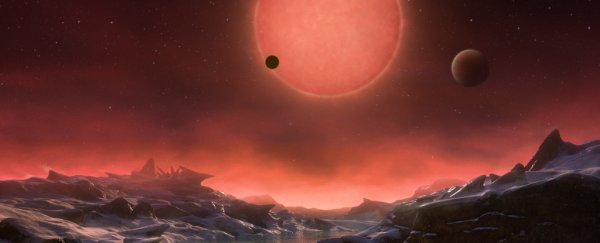Three new exoplanets have been found orbiting a nearby star, and one of them is ranked pretty highly for potential habitability.
All three are rocky, and within the vicinity of Earth-sized - and the outermost is orbiting the star in the habitable zone, where temperatures are compatible with the possibility of liquid water on the surface.
The star is Gliese 1061, at a distance of 3.67 parsecs - around 12 light-years away - making it the 20th closest star to the Solar System. And its three planets are Gliese 1016 b, Gliese 1016 c and Gliese 1016 d.
The research team also found evidence that could indicate a fourth planet, but ultimately ruled it out as stellar activity. The findings are reported on preprint server arXiv, and have been submitted to the Monthly Notices of the Royal Astronomical Society.
Gliese 1061 is a red dwarf. These stars are cool and faint, which means their habitable zone is a lot closer to the star than a hotter, brighter star - like the Sun, for instance. And planets orbiting their stars closely are easier to find than stars much farther out.
This makes them a great target for habitable exoplanet searches, but that doesn't mean they're necessarily hospitable.
Red dwarfs are often restless and wild, lashing the space around them with stellar flares.
Such is the case with Proxima b, the rocky exoplanet found orbiting in the habitable zone of our nearest stellar neighbour, Proxima Centauri.
Gliese 1061 is a lot like Proxima Centauri, but there is one key difference: it's a heck of a lot quieter. Which means - you guessed it - potentially higher chances of habitability.
All three planets were detected using the radial velocity, or "wobble", method.
While many exoplanets are identified by looking at dips in light as the planets pass between us and their star (the transit method), in this instance, the stars' orbits are angled so that they never pass between us and the star. That means we have to detect them using gravity.
You see, although it seems like a star might be more or less fixed in position, the planet and the star actually orbit a mutual centre of gravity. This is usually inside the star, since it is so much more massive than its planets, but the tug of the planet is enough to pull the star just ever-so-slightly off-centre as it moves around.
If you have precise enough detection methods - which we do - this wobble can be used not just to infer the presence of a planet (or several planets), but to calculate their mass, based on how much the star is wobbling.
This returned some pretty interesting masses for Gliese 1061's planets. Gliese 1016 b - the innermost planet - is 1.38 times the mass of Earth. The middle planet, Gliese 1016 c, is 1.75 times the mass of Earth. And the outermost planet, Gliese 1016 d, is 1.68 times the mass of Earth.
This is also how we infer the planets are rocky, since those masses are rarely seen in gaseous exoplanets.
All three planets orbit the star much closer than any of the Solar System's planets. Gliese 1016 b whips round every 3.1 days; Gliese 1016 c every 6.7 days; and Gliese 1016 d every 13 days. The star is so cool that these orbits place Gliese 1016 d in the habitable zone, and Gliese 1016 c is right on the innermost cusp of the habitable zone.
Of course, this doesn't mean life is waiting for us to find it just 12 light-years away.
As the researchers note, the star may be relatively quiet now, but it probably was quite active in its recent past. If it has been bathing its planets in stellar radiation, any life that was there is unlikely to have survived.
But it does add to the tally of rocky planets in nearby space. According to the Exoplanet Archive, somewhere in the vicinity of 70 exoplanets have been located within 10 parsecs (32.6 light-years) of the Solar System, many of them small and possibly rocky.
And just a couple of months ago, astronomers revealed the presence of two Earth-like planets orbiting Teegarden's star 12.5 light-years away. With at least half of all red dwarf stars thought to have rocky planets, our local neighbourhood suddenly seems quite bustling, really.
The research has been submitted to the Monthly Notices of the Royal Astronomical Society, and is available on arXiv.
